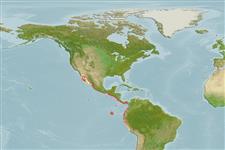Environment: milieu / climate zone / depth range / distribution range
Ecologia
marino; salmastro; distribuzione batimetrica 0 - 142 m (Ref. 96339). Tropical; 31°N - 14°S, 115°W - 76°W (Ref. 189)
Eastern Pacific: San Juanico Bay, northern Gulf of California southward to Callao, Peru and perhaps further south. The record from Santa Margarita Island on the Pacific coast of Baja California, Mexico is based solely on the now lost type of Stolephorus cultratus.
Length at first maturity / Size / Peso / Age
Maturity: Lm 6.0 range ? - ? cm
Max length : 17.0 cm TL maschio/sesso non determinato; (Ref. 96339); common length : 8.0 cm TL maschio/sesso non determinato; (Ref. 55763); peso massimo pubblicato: 26.90 g (Ref. 130775)
Short description
Chiavi di identificazione | Morfologia | Morfometria
Spine dorsali (totale) : 0; Spine anali: 0; Raggi anali molli: 20 - 25. Fairly elongate. Snout long, about 3/4 eye diameter or more; maxilla long, tip pointed, reaching almost to gill opening; gill cover canals of panamensis-type; pseudobranch longer than eye diameter, with 30 or more filaments, extending onto inner face of operculum. Anal fin origin under or just behind base of last dorsal fin ray. Silver stripe along flank about eye diameter.
A schooling species occurring in coastal waters, near shores, entering bays and tolerating some lowering of salinity. Spawns throughout the year, but more intensively in the warmer months. The eggs are oval. The most important tuna baitfish in Manta, Ecuador.
Life cycle and mating behavior
Maturità | Riproduzione | Deposizione | Uova | Fecundity | Larve
Spawns more intensively in the warmer months (Ref. 189). Spawn in school (Ref. 205).
Whitehead, P.J.P., G.J. Nelson and T. Wongratana, 1988. FAO Species Catalogue. Vol. 7. Clupeoid fishes of the world (Suborder Clupeoidei). An annotated and illustrated catalogue of the herrings, sardines, pilchards, sprats, shads, anchovies and wolf-herrings. FAO Fish. Synop. 125(7/2):305-579. Rome: FAO. (Ref. 189)
IUCN Red List Status (Ref. 130435: Version 2024-2)
Threat to humans
Harmless
Human uses
Pesca: scarso interesse commerciale; esca: usually
Strumenti
Special reports
Download XML
Fonti Internet
Estimates based on models
Preferred temperature (Ref.
123201): 17.2 - 28.9, mean 25 °C (based on 142 cells).
Phylogenetic diversity index (Ref.
82804): PD
50 = 0.5000 [Uniqueness, from 0.5 = low to 2.0 = high].
Bayesian length-weight: a=0.00513 (0.00234 - 0.01125), b=3.14 (2.97 - 3.31), in cm total length, based on LWR estimates for this Genus-body shape (Ref.
93245).
Trophic level (Ref.
69278): 3.4 ±0.4 se; based on size and trophs of closest relatives
Resilienza (Ref.
120179): Alto, tempo minimo di raddoppiamento della popolazione meno di 15 mesi (Preliminary K or Fecundity.).
Prior r = 0.99, 95% CL = 0.65 - 1.48, Based on 1 data-limited stock assessment.
Fishing Vulnerability (Ref.
59153): Low vulnerability (10 of 100).
Nutrients (Ref.
124155): Calcium = 342 [173, 916] mg/100g; Iron = 2.65 [1.40, 4.89] mg/100g; Protein = 17.3 [14.9, 20.0] %; Omega3 = 0.344 [0.159, 0.725] g/100g; Selenium = 75.5 [31.2, 191.0] μg/100g; VitaminA = 13.2 [3.8, 38.1] μg/100g; Zinc = 2.24 [1.47, 3.43] mg/100g (wet weight);
